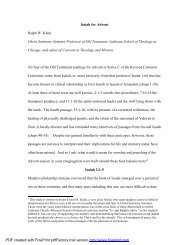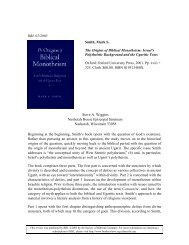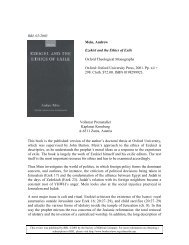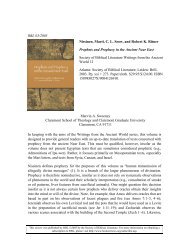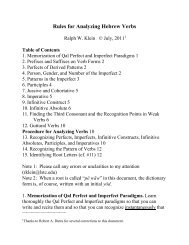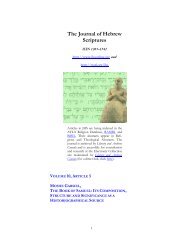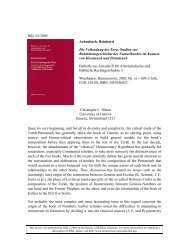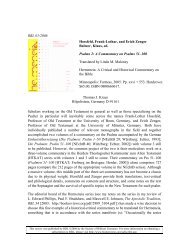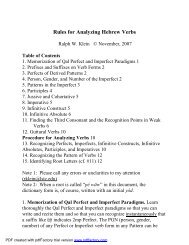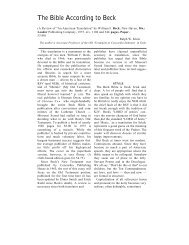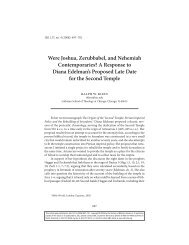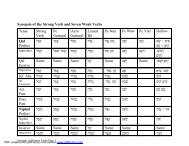could saul rule forever? a new look at 1 samuel 13:13-14
could saul rule forever? a new look at 1 samuel 13:13-14
could saul rule forever? a new look at 1 samuel 13:13-14
You also want an ePaper? Increase the reach of your titles
YUMPU automatically turns print PDFs into web optimized ePapers that Google loves.
Freedman and Miano. 17 It is my opinion th<strong>at</strong> N<strong>at</strong>han’s oracle<br />
should be d<strong>at</strong>ed to the Tenth century BCE. 18 The covenant<br />
between God and David contains elements of vassal tre<strong>at</strong>ies<br />
known to us from Hittite texts from the thirteenth century BCE. 19<br />
In addition, the description of a king who desires to build a<br />
house for his god is well <strong>at</strong>tested in hymns and royal building<br />
inscriptions from the early beginnings of civiliz<strong>at</strong>ion. 20 If my<br />
arguments are sound, then the conclusion might be th<strong>at</strong> allusions<br />
made by the author of Samuel to N<strong>at</strong>han’s oracle in 2 Samuel 7<br />
17 D.N. Freedman and D. Miano, “The People of the New Covenant,”<br />
in The Concept of the Covenant in the Second Temple Period, eds. S.E. Porter and<br />
J.C.R. de Roo (JSJSup, 71; Leiden: E.J. Brill, 2003), 7-26. See also M.<br />
Haran, “The Bĕrit ‘Covenant’: Its N<strong>at</strong>ure and Ceremonial Background”,<br />
in Tehilla le-Moshe: Biblical and Judaic Studies in Honor of Moshe Greenberg, eds.<br />
M. Cogan et al. (Winona Lake, IN: Eisenbrauns), 203-19; J. Milgrom,<br />
“Covenants: The Sinaitic and P<strong>at</strong>riarchal Covenants in the Holiness Code<br />
(Leviticus 17–27)”, in Sefer Moshe: The Moshe Weinfeld Jubilee Volume, eds.<br />
C.A. Cohen et al. (Winona Lake, IN: Eisenbrauns, 2004), 91-101.<br />
18 For an early d<strong>at</strong>e of the book of Samuel, see recently B. Halpern,<br />
David’s Secret Demons: Messiah, Murderer, Traitor, King (Grand Rapids, MI:<br />
Eardmans, 2001), 57-72.<br />
19 See P.J. Calderone, Dynastic Oracle and Suzerainty Tre<strong>at</strong>y (Manila:<br />
Manila University, 1966); J. Kim, Psalm 89: Its Biblical-Theological Contribution<br />
to the Presence of Law within the Unconditional Covenant (PhD dissert<strong>at</strong>ion; Ann<br />
Arbor, MI, 1989), 351 ff.<br />
20 V.A. Hurowitz, I Have Built You an Exalted House. Temple Building in<br />
the Bible in Light of Mesopotamian and Northwest Semitic Writings (JSOTSup,<br />
115; Sheffield: Sheffield Academic Press, 1992); Richard E. Averbeck,<br />
“Sumer, the Bible, and Compar<strong>at</strong>ive Method: Historiography and Temple<br />
Building,” Mesopotamia and the Bible: Compar<strong>at</strong>ive explor<strong>at</strong>ions (eds. M.W.<br />
Chavalas and K. Lawson Younger, JR.; Grand Rapids: Baker, 2002), 88-<br />
125; M. Avioz, N<strong>at</strong>han’s Oracle (2 Samuel 7) and Its Interpreters (Bern: Peter<br />
Lang, forthcoming).<br />
8





